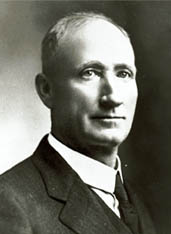From Oil Creek to Spindletop

Yesterday was the birth anniversary of Benjamin Silliman, Jr. (born in 1816 in New Haven, Connecticut, died there on January 14, 1885), a Yale chemist and son of American science pioneer Benjamin Silliman, Sr., who was hired by the promoters of the nascent Pennsylvania oil industry to analyze seep oil and who discovered the practical uses for petroleum -- in particular, that petroleum could be refined into mighty fine kerosene. Silliman's report ("Report on Rock Oil, or Petroleum, from Venango County, Pennsylvania," 1855) was used in raising funds for the wells drilled by "Colonel" Edwin Drake, an ex-railroad conductor who struck oil at 69-1/2 feet below the surface at Oil Creek, Pennsylvania on August 28, 1859.
The Oil Creek strike launched a frenzied oil rush in Western Pennsylvania and Eastern Ohio, ultimately drawing in and making the fortunes of the Rockefeller clan and countless others.
 In 1901, however, a one-armed amateur geologist almost singlehandedly (please excuse the pun) shifted the entire focus of the American oil industry to Texas and the Southwest.
In 1901, however, a one-armed amateur geologist almost singlehandedly (please excuse the pun) shifted the entire focus of the American oil industry to Texas and the Southwest.Pattillo Higgins (born on this day in 1863 in Sabine Pass, Texas) lost an arm during a gunfight with a deputy sheriff when he was 17. Claiming self-defense, he somehow emerged without being convicted, and thereafter became a born-again Baptist and a brick and glass entrepreneur.
Throughout the 1890s, Higgins told anyone who would listen that there was oil underneath Spindletop Hill, an otherwise worthless piece of land near Beaumont, Texas -- experiencing reactions that ranged from pity for a "harmless fanatic" to "he may have a point there." Higgins turned out to be correct, and when "Captain" Anthony Lucas' first Spindletop well gushed mud, rocks and crude oil 200-feet into the air in January 1901, the Texas oil industry was born. Cheated out of the financial benefit of Lucas' well by the terms and conditions required by Lucas' investors (who numbered among them banker and Treasury secretary Andrew Mellon), Higgins sued, received some settlement money, and proceeded to develop some of the most productive wells on the Spindletop acreage by himself. Thereafter, Texas was the Mecca and the playpen of the major petroleum developers, and Western Pennsylvania as an area for oil exploration was relegated to poor sister status.
A living embodiment of the boom-and-bust rhythms of the oil industry in general, Higgins gained and lost millions over the span of his petroleum career. He died on June 5, 1955 in San Antonio, Texas.





0 Comments:
Post a Comment
Subscribe to Post Comments [Atom]
<< Home